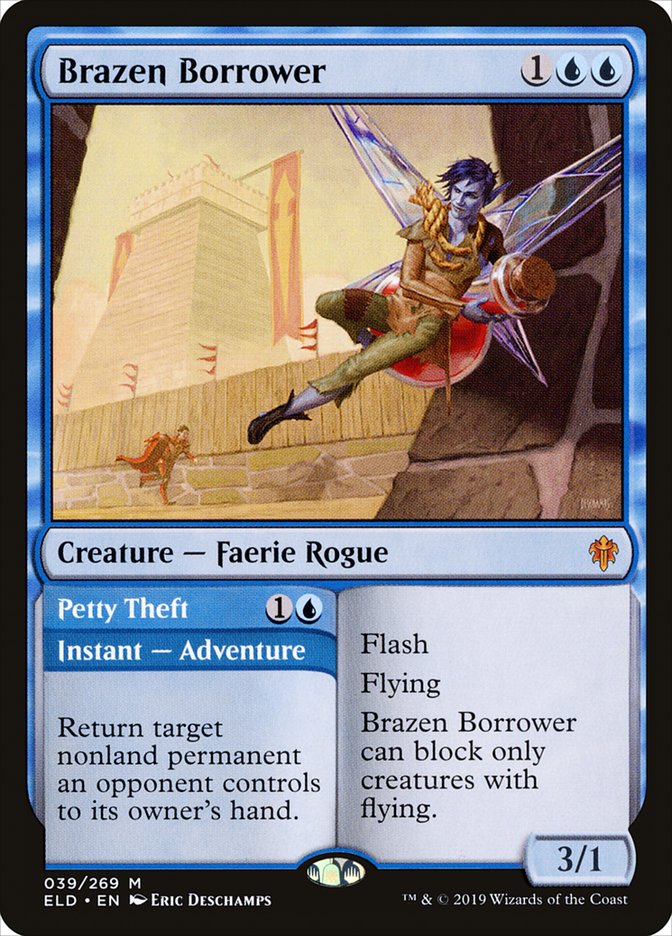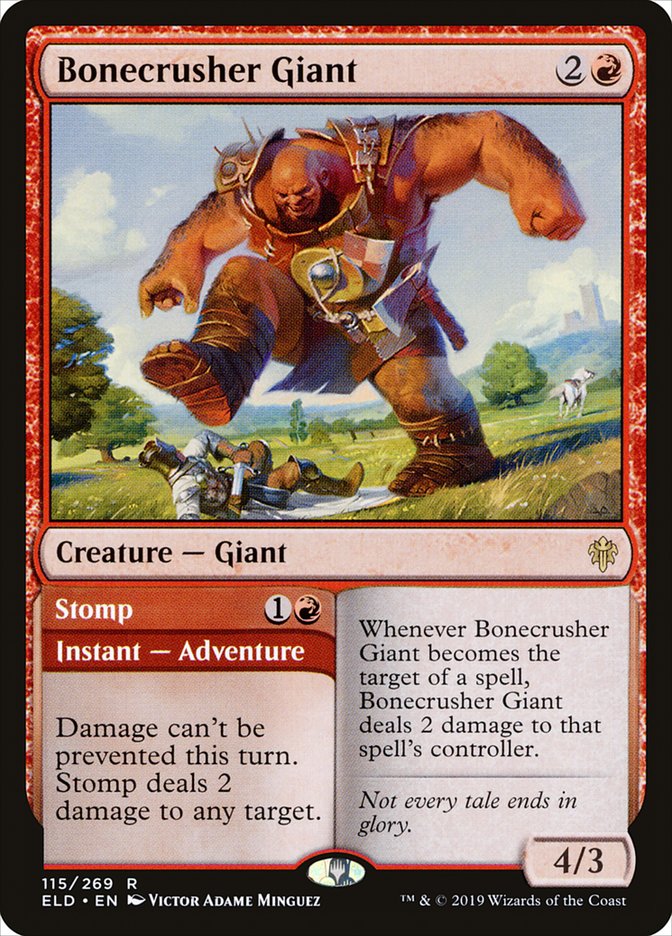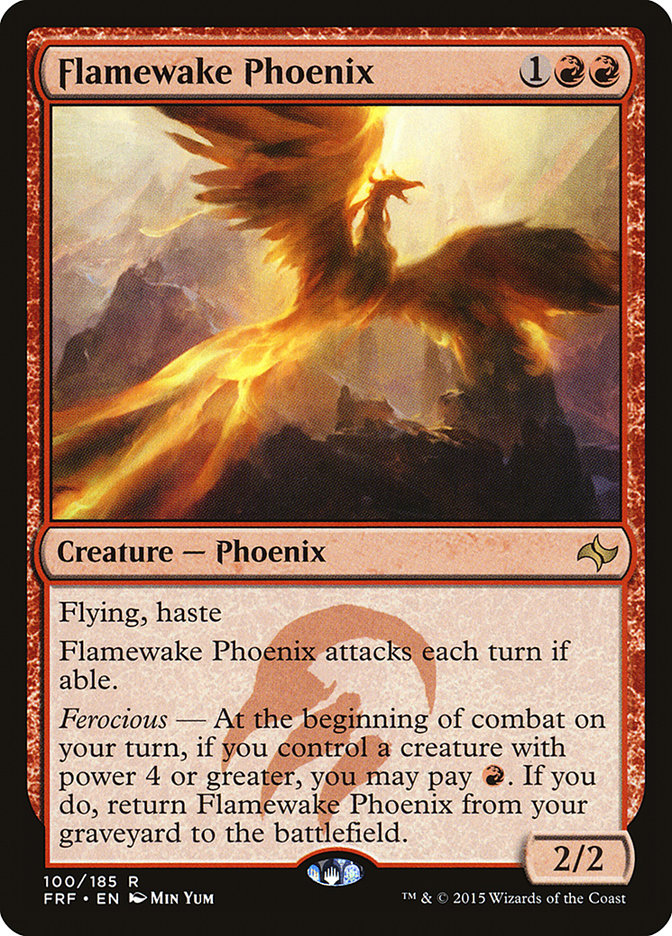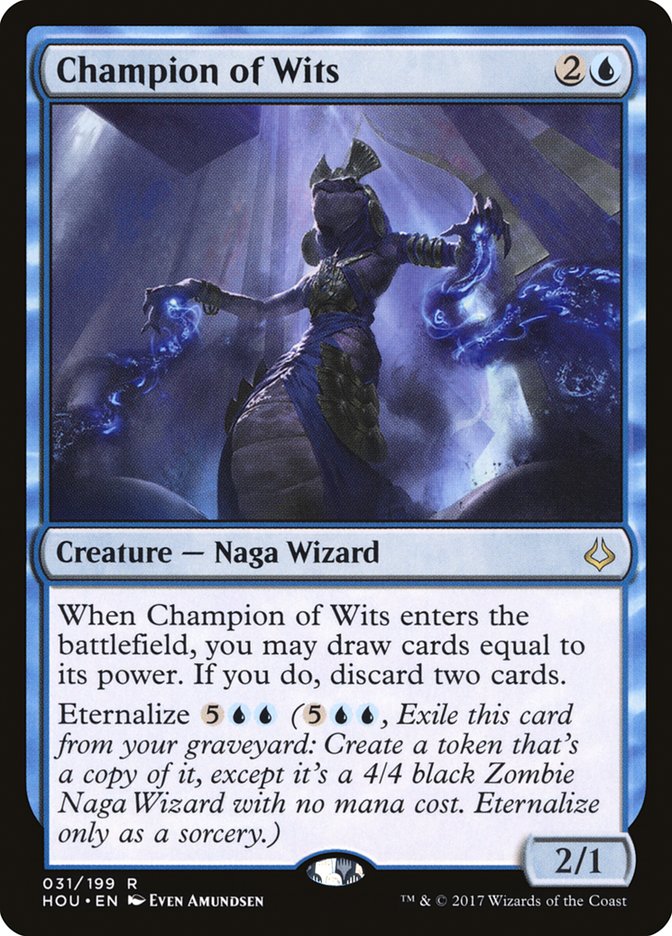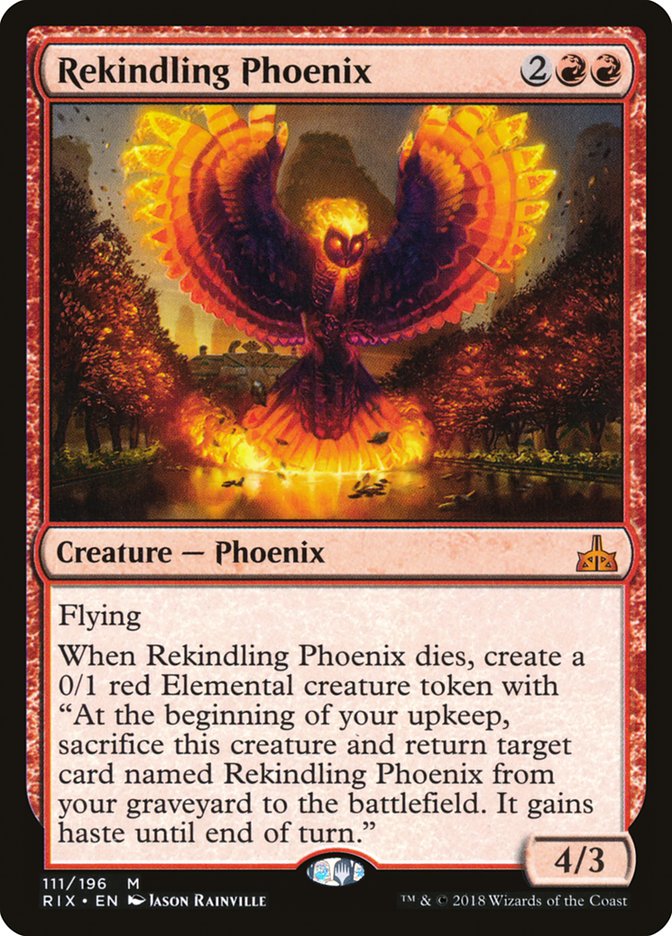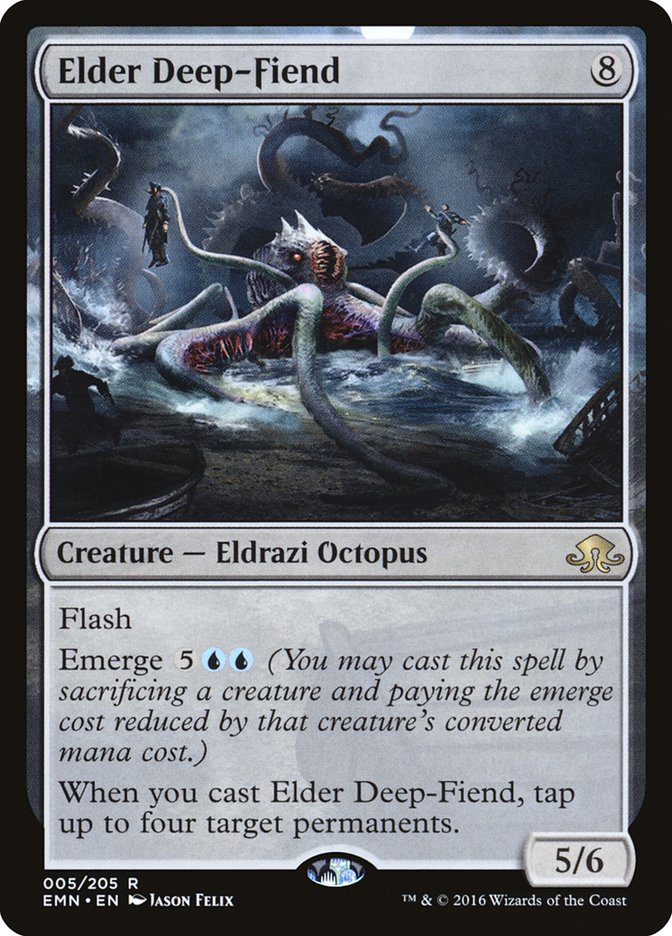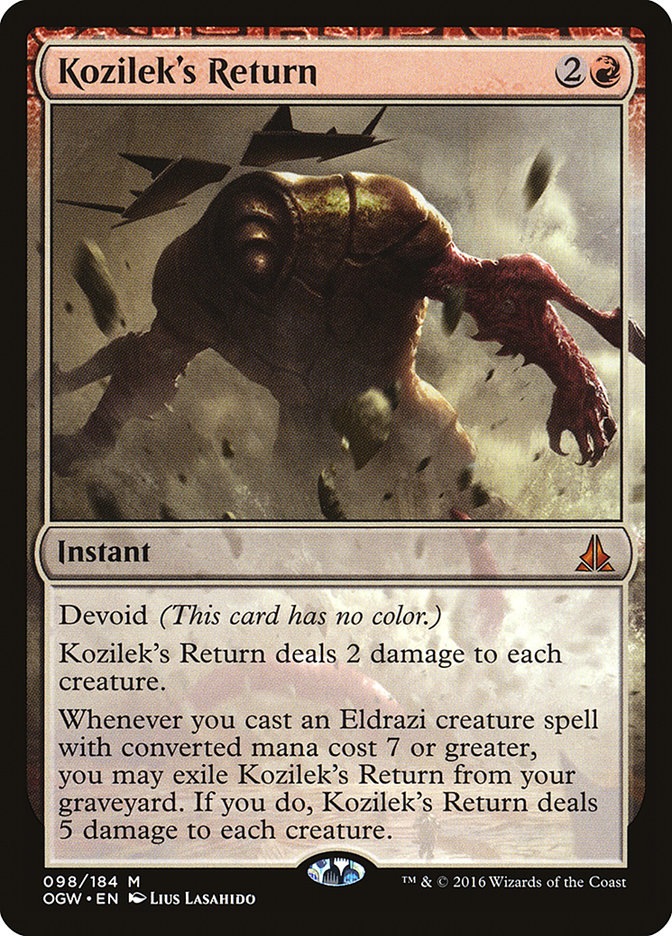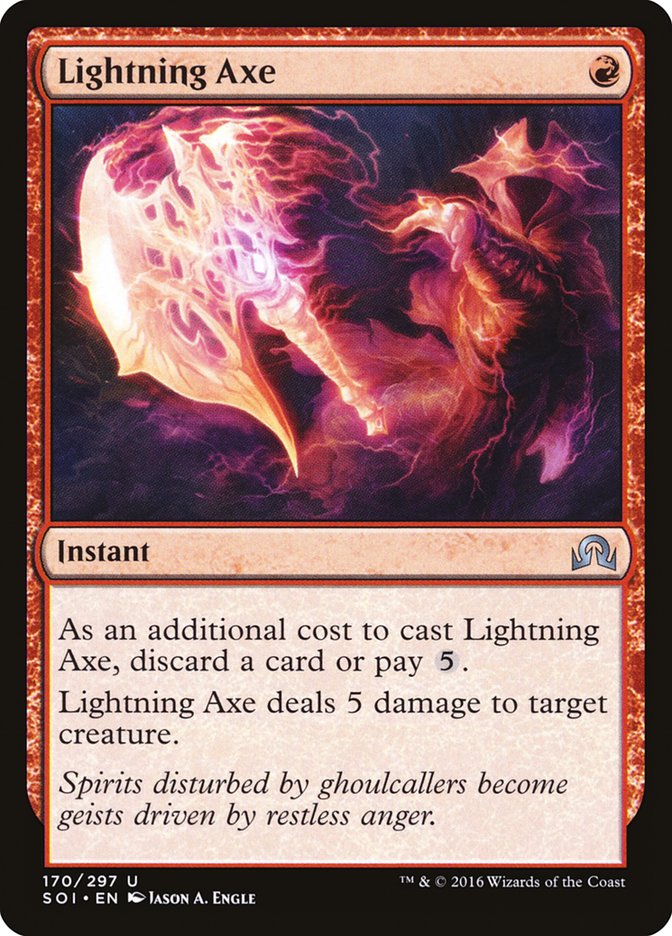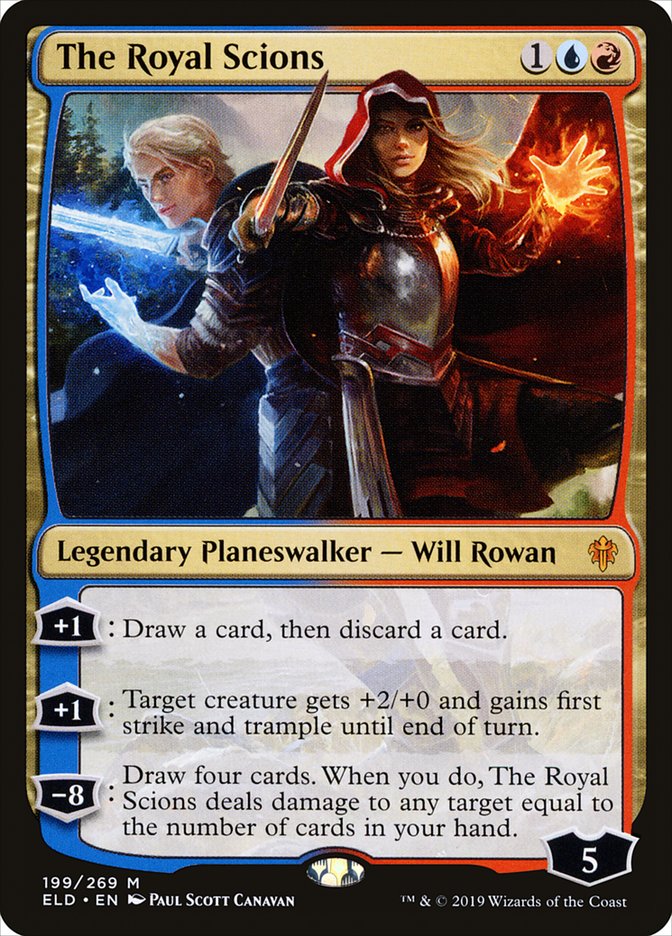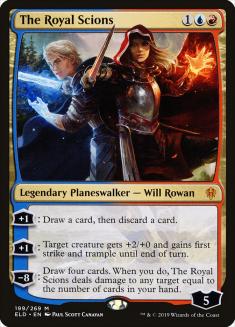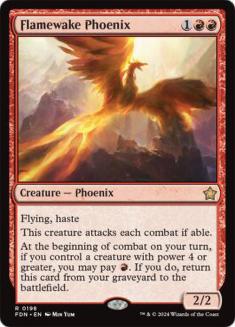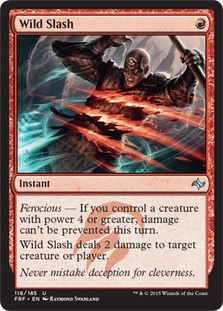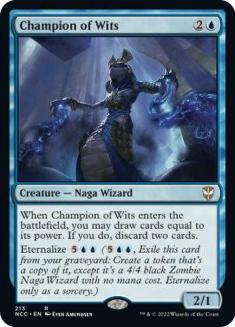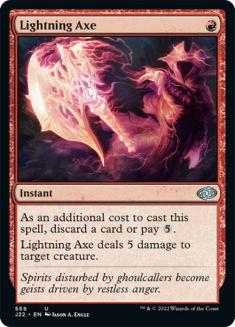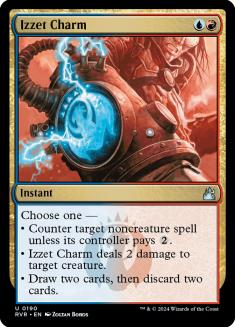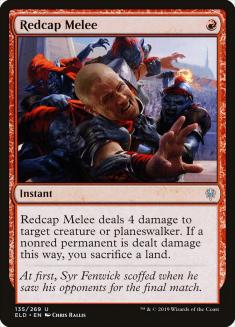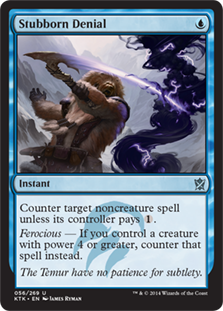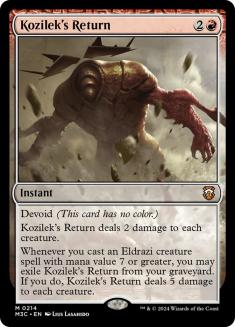SCG CON Winter, and with it the Season Two Invitational, has come and gone. Players’ Championship tickets were punched, Prize Wall tickets were redeemed, and three intense days of Magic culminated in a dominant performance by Christopher Barone, who won the Season Two Invitational based off his strong performance with Mono-Black Aggro in Pioneer. Chris was one of four players to post a 7-1 or better Pioneer performance with Mono-Black, one of the decks to beat coming into the weekend. Mono-Green Devotion, to its credit, was responsible for two slots in the Top 8 and also performed fairly well.
I knew, as soon as I began testing, that I wanted to beat these two decks for this event. I also expected a smattering of Mono-Red Aggro, sometimes with a splash, and Izzet Phoenix. As soon as I saw JeremyMandel’s list from last weekend’s Pioneer Challenge, I knew I had found something I really wanted to work on for the Invitational.
Creatures (22)
- 4 Flamewake Phoenix
- 4 Elder Deep-Fiend
- 2 Champion of Wits
- 4 Rekindling Phoenix
- 4 Bonecrusher Giant
- 4 Brazen Borrower
Planeswalkers (2)
Lands (24)
Spells (12)
Sideboard

Kozilek’s Return is so obviously well-positioned against the aforementioned aggressive decks and Devotion decks that I was determined to stay working on it despite frustrating losses to Field of the Dead and Nexus of Fate decks early on.
Even considering the problems with control and grindy decks, Izzet Emerge is designed beautifully for exploiting a creature-heavy metagame. The Adventure creatures do a fantastic job of keeping the battlefield manageable while also ensuring you have a creature for Elder Deep-Fiend. It’s an incredibly synergistic design that helps to mitigate the cost of playing a card like Elder Deep-Fiend that has a huge payoff and a significant drawback.
The main things this deck is trying to do are poised to exploit a few holes in the early Pioneer metagame, chiefly the vulnerability of small creatures to Kozilek’s Return and the propensity for decks to operate mostly at sorcery speed. The deck I actually registered was four cards off the one that came in second in the challenge. It was a 5-0 list played by Jeff Hoogland that was posted earlier this month.
Creatures (22)
- 4 Flamewake Phoenix
- 4 Elder Deep-Fiend
- 2 Champion of Wits
- 4 Rekindling Phoenix
- 4 Bonecrusher Giant
- 4 Brazen Borrower
Planeswalkers (2)
Lands (24)
Spells (12)
Sideboard

Jeff played two copies of The Royal Scions over the two Chandra, Torch of Defiance and played two copies of Sanctum of Ugin instead of a third Mutavault and a Wandering Fumarole. I believe that the addition of Sanctum of Ugin was a reaction to the Veil of Summer ban and the natural uptick in attrition-based midrange and control decks as a consequence of said ban.
I believe Sanctum of Ugin warrants inclusion here, as you’re rather poorly positioned against decks that can efficiently remove Elder Deep-Fiend and/or don’t care about your Kozilek’s Return.
Izzet Emerge is best when it’s a control deck with a great closing speed but it can struggle when it’s forced to be the beatdown. I think Sanctum of Ugin and The Royal Scions both help to remedy this; Sanctum because you can start chaining Elder Deep-Fiend and The Royal Scions because you can put a threat on the battlefield that forces them to act as early as Turn 3.
Some of the cards have interesting applications and interesting roles in the list. I figured breaking them into groups based on their general roles would be a valuable way to explain the role of each card and the reasons for their inclusion.
I’m of the opinion that without these creatures, Izzet Emerge wouldn’t be a viable strategy. The biggest strength of the Adventure creatures is that they pair with Elder Deep-Fiend and allow you to have a full curve using only two cards. You cast the adventure on Turn 2, the creature on Turn 3, and Elder Deep-Fiend on the upkeep of your opponent’s fourth or fifth turn depending on play/draw.
This deck is mana-hungry and needs to hit at least its first four land drops, if not the first five to six. Having one card that allows you to efficiently spend mana is great because you can keep a four- or even sometimes a five-land hand because your other two cards are an Elder Deep-Fiend and a Brazen Borrower or Bonecrusher Giant.
You have several filtering agents that will let you discard excess lands later on, so don’t be afraid to keep land heavy-hands if they have the aforementioned one-two punch. Don’t forget you can prevent Fog and similar effects with the Stomp half of Bonecrusher Giant against Simic Nexus and that Brazen Borrower can be used to bounce something and then can keep it off the battlefield for two turns with an upkeep Elder Deep-Fiend.
These cards represent the creatures that are synergistic with Elder Deep-Fiend and also provide great targets to sacrifice for the emerge ability. Champion of Wits is simply a good value creature that helps hit land drops and provides flood insurance. Both Phoenixes will come back on the next turn provided that the token or the Elder Deep-Fiend doesn’t get removed. Rekindling Phoenix is also a fantastic blocker and the resilient creature’s stock has gone up as more people are playing fair cards and removal spells after the Veil of Summer ban. Flying is often your key to victory, as your Elder Deep-Fiend will hold back their ground creatures and allow you to pressure them in the air.
These two cards represent the most unfair part of Izzet Emerge. All the other creatures in the deck are included because they have some value with Elder Deep-Fiend, be it coming back from the graveyard or doing something before they enter the battlefield. There are several tricky ways to use Elder Deep-Fiend besides the obvious “upkeep tap your lands” play that are worth mentioning.
One thing you can do is wait until the end of your opponent’s turn so you can tap blockers or mana that could be used to stop your attackers. This can let you freely activate Wandering Fumarole or Mutavault to get the maximum damage out of your creature-lands.
Another trick that is more relevant now that Veil of Summer’s ban has reinvigorated control and midrange decks is the option to use your Elder Deep-Fiend as a way to blank removal. This is especially good with either of the Phoenixes because they can come back but also works fine with any of the threats in the deck.
Basically, you hold up your Elder Deep-Fiend and don’t cast it until they try to kill one of your creatures. Then you sacrifice the targeted creature so you don’t lose a card to emerge as well as their removal spell. This trick is best against control when you can’t afford to sacrifice your threats since they have so much interaction. It’s also especially effective when the opponent has cards that exile your threats such as Declaration in Stone, Settle the Wreckage, or Vraska’s Contempt.
As far as Kozilek’s Return is concerned, the important things to know are twofold. Firstly, you should be casting the card more often than you think. Several of your creatures survive it and it’s the best way to handle the mana creatures from the green decks. That said, be careful using it too early against Field of the Dead decks. Don’t sweep five Zombies when you’re at 18 and lose because they made chump blockers afterwards. Try to engineer turns so that your Deep-Fiends lead to chunks of damage and don’t forget you can tap Fabled Passage so they can’t make a blocker post-Return. You can tap Field of Ruin to hit with a creature-land if you have two (if you have one they’ll just activate in response).
Another brief aside on tapping stuff; be sure to avoid tapping utility lands, as it is usually better to tap all the other lands and force them to use their utility land right then and there. For example, if an opponent has four lands and Castle Vantress, you should tap the four non-Castle lands because they’re likely to just cash the floating mana in for an activation. Obviously, this isn’t always true and situations where they’re representing Mystical Dispute or Dispel come to mind, but generally this will let you essentially tap an extra permanent.
Being patient with your Elder Deep-Fiend in fair matchups will often pay dividends. Consider what you’re doing with the free turn and remember you don’t have to upkeep it just because it taps lands and has flash.
Secondly, the backside of Kozliek’s Return goes on the stack and passes priority, almost like a spell would. However, it’s a may ability, not a must. Therefore, you aren’t required to exile it and you can save it for a second Elder Deep-Fiend if things change in response. This is relevant with the addition of Sanctum of Ugin since it increases the likelihood that you can reliably chain Deep-Fiends together. This also comes up when players can do things to protect their creatures such as sacrifice Food to Wicked Wolf, flash in Archangel Avacyn, or sacrifice a Selfless Spirit. If they take any of these actions, remember you can choose to not exile Kozilek’s Return, saving it for later.
This is your removal suite and both are also able to serve as outlets for discarding some of the ancillary graveyard cards. A common sequence is to Stomp something on Turn 2; keep up Izzet Charm on Turn 3, looting at end of turn; and cast your Bonecrusher Giant and return a Flamewake Phoenix on Turn 4. You can obviously cast Bonecrusher Giant on Turn 3 and return Flamewake Phoenix on Turn 4, but deploying both in the same turn will put more pressure on the opponent’s mana in that one turn cycle and increase the chances you can emerge Elder Deep-Fiend off Flamewake Phoenix, the optimal target for the ability.
Izzet Charm has diminishing returns both with regards to using the looting mode a second time and holding one in your hand throughout the game. Two of the abilities are best in the early-game and the looting ability is valuable throughout but can be great when you’re holding a few lands in the late-game. Lands are generally good on the battlefield, though, so usually you’ll be cashing the card in sometime in the first four turns.
Lightning Axe is pretty self-explanatory and you should kill anything you can against Mono-Red Aggro and Mono-Black Aggro. In sideboard games, you might want to save Lightning Axe for Kalitas, Traitor of Ghet but remember that you can kill Golos, Tireless Pilgrim with Lightning Axe; a reason to consider leaving the card in against Field of the Dead ramp decks.
The Royal Scions used to be two copies of Chandra, Torch of Defiance but I think the change is slightly better because it can help break through chump blockers and provides a source of filtration that can discard excess lands as well as bin your cards that have graveyard interactions. It can also add power to a creature immediately to finish off a planeswalker. The ultimate is reached earlier than Chandra’s and also provides reach while also adding some serious card advantage. The Sultai Midrange matchup is one where Chandra might’ve been better as the value of extra cards and removal is pretty important there specifically.
Sideboarding
VS Mono-Black Aggro
Out:
In:
Pretty simple here. The Royal Scions doesn’t impact the battlefield when you’re behind and Flamewake Phoenix is the worst of the creatures at blocking, which you’ll be doing often until you find your Kozilek’s Return.
VS Mono-Red Aggro
Out:
In:
We have a preponderance of removal and this is mostly just upgrading spells to be more powerful and more relevant. It’s possible the Stubborn Denials aren’t good, but you have enough removal that losing to their reach is going to prove to be frustrating. Games can go long so Aether Gust and Stubborn Denial are better than Izzet Charm.
VS Mono-Green Devotion
Out:
In:
Sideboarding like this is going to impact your ability to filter away lands or dig into needed lands but you’ll be occupied with hampering their early-game anyway most of the time. You really don’t have time to cast Flamewake Phoenix or Champion of Wits and the flyer has much more value when you’re pressuring ‘walkers and their life total.
VS Simic Nexus
Out:
In:
Don’t forget that Simic Nexus is likely sideboarding in a pile of Tireless Trackers. Save your Stomps to answer those or to help answer their Fogs. Elder Deep-Fiend is great here so Champion of Wits is a bit better than The Royal Scions, but splitting them makes sense to me because getting The Royal Scions on the battlefield and ticking it up can really put pressure on them as you’ll have a lot of cards in hand most of the time.
VS Sultai Midrange
Out:
In:
I don’t want the card disadvantage of Lightning Axe against an attrition-based deck and Stubborn Denial is nice to catch an early Oko, Thief of Crowns, especially on the draw. I don’t want too many because they can leverage Thoughtseize and leave them stuck in your hand. I keep two Axes in for The Scarab God and leave Kozilek’s Return as insurance against that as well. This matchup seemed pretty hard as they can kill your Elder Deep-Fiends while also having some really powerful and resilient threats. This is the place where you’ll want to get in every bit of damage with your creatures. Don’t overvalue the upkeep Deep-Fiend because they can kill it at instant speed with cards like Assassin’s Trophy, Cast Down, or Oko.
I didn’t make a huge splash at the Season Two Invitational, as a disappointing 1-3 in Modern kept me out of Day 2. I did manage a 3-1 with Izzet Emerge during the Pioneer portion of Day 1, crushing Mono-Green Devotion twice and beating an interesting Mardu Midrange deck while losing to Golgari Delirium in the hands of Stephen Dykman, who crashed through into the Top 8 after starting 8-0 Day 1.
Moving forward, creatures with huge power and toughness are obviously difficult for us to deal with, so Entrancing Melody could shore up a lot of the weaknesses to cheap large creatures. Goblin Rabblemaster and Questing Beast are both pretty powerful and well-positioned cards, but they both make decent targets for Melody. I also think Sorcerous Spyglass could be useful against a card like Scavenging Ooze, which I struggled with quite a bit on Day 1.
That all said, I still recommend Izzet Emerge for Pioneer moving forward. I think the creature decks and Mono-Green Devotion will stay popular and powerful, keeping Kozilek’s Return relevant for a while, at least.


